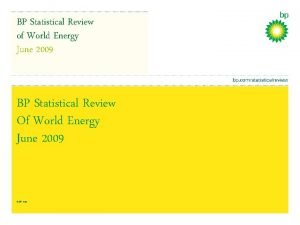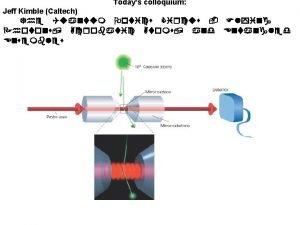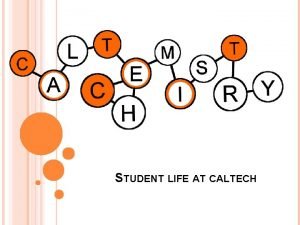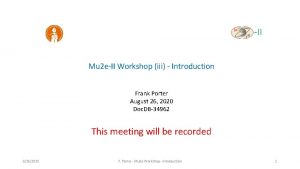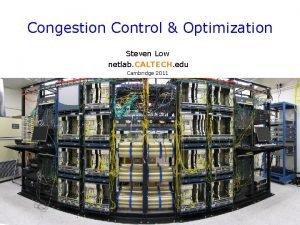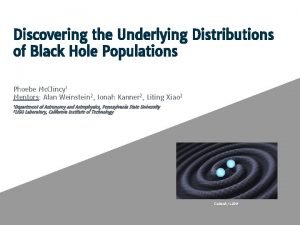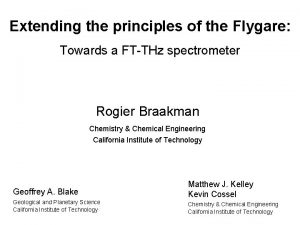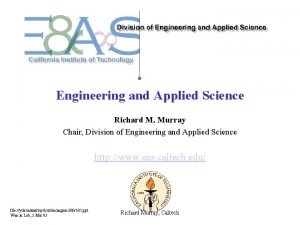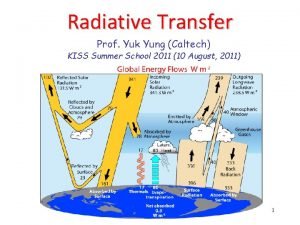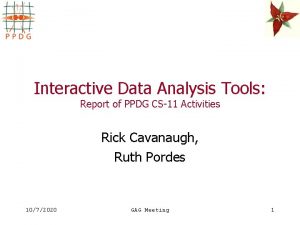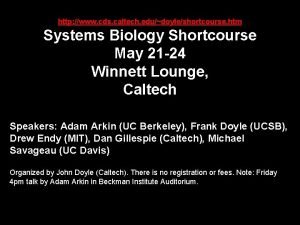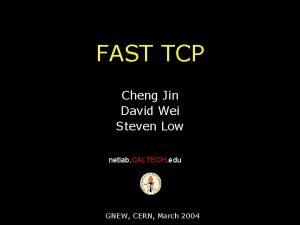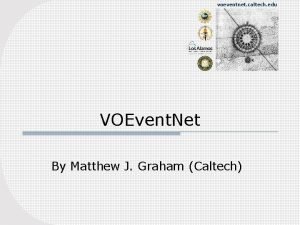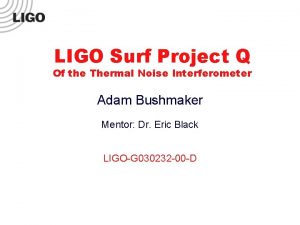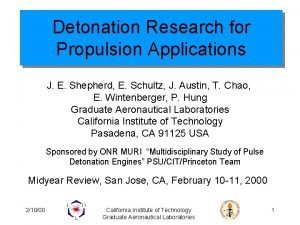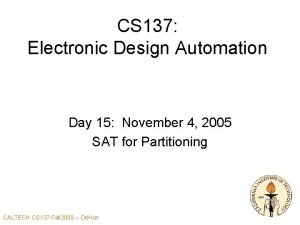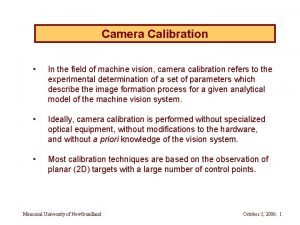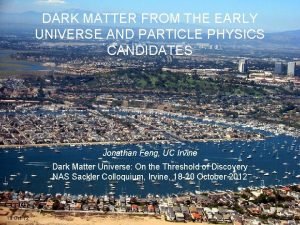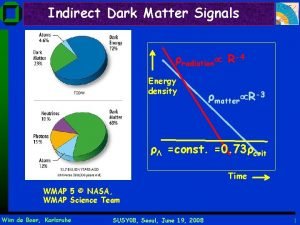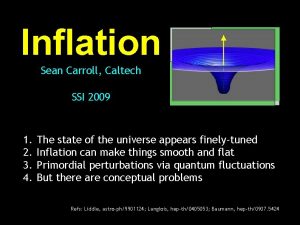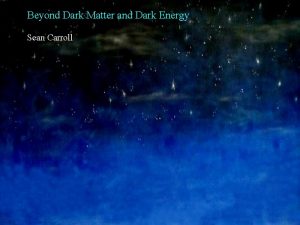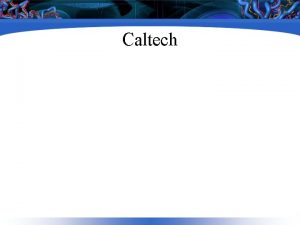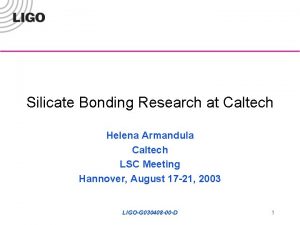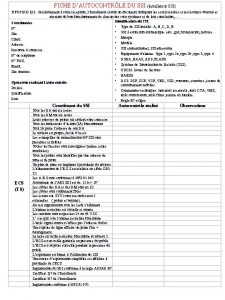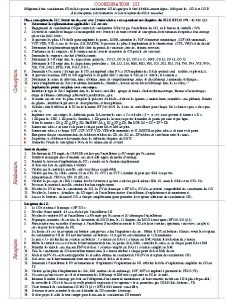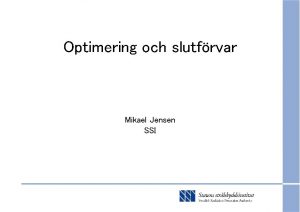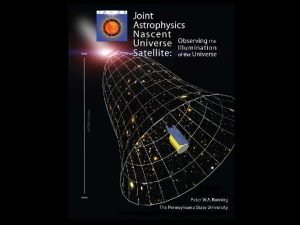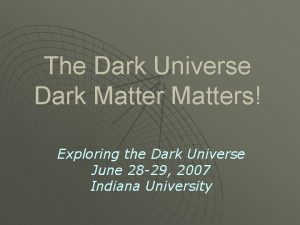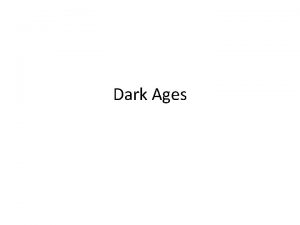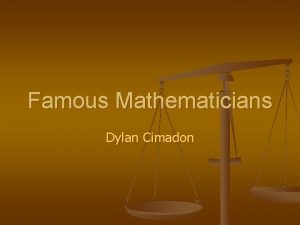70 Dark Energy Sean Carroll Caltech SSI 2009





























![4. Modified Gravity Simplest possibility: replace with [Carroll, Duvvuri, Trodden & Turner 2003] The 4. Modified Gravity Simplest possibility: replace with [Carroll, Duvvuri, Trodden & Turner 2003] The](https://slidetodoc.com/presentation_image_h/f37edc31dae75c0d212004cd6d1bf5c3/image-30.jpg)







- Slides: 37

70% Dark Energy Sean Carroll, Caltech SSI 2009 1. 2. 3. 4. 25% Dark Matter 5% Ordinary Matter Evidence for Dark Energy Vacuum Energy and the Cosmological Constant Dynamical Dark Energy and Quintessence Was Einstein Right?

1. Evidence for Dark Energy Dec. 1997: Something was in the air! - age of the universe - absence of power on small scales - measurements of matter density Theorists had a favorite model: a flat universe, full of matter (ordinary + cold dark), with primordial scale-free perturbations. That model couldn’t be right! Something had to give -“flat, ” “cold, ” “scale-free, ” or perhaps even “matter. ”

The Friedmann equation with matter and radiation: Multiply by a 2 to get: If a is increasing, each term on the right is decreasing; we therefore predict the universe should. be decelerating (a decreasing). a > Big Bang < t

T Two groups went out to look for the ‘deceleration’ o of the universe, using type Ia supernovae as standardizable candles. SN 1994 d

Result: supernovae are dimmer than expected. The universe is not decelerating at all, it’s accelerating. Can’t be explained by matter and radiation. [Riess et al. ; Perlmutter et al. ; Knop et al. ]

What could make the universe accelerate? From the Friedmann equation, we need something that doesn’t dilute away as the universe expands. Call it dark energy. accelerating size decelerating > Big Bang < time

If the dark energy density evolves as then a DE-dominated universe obeys which implies acceleration for But people usually use the “equation-of-state parameter” so that acceleration happens for

Fun non-Euclidean fact: “constant expansion rate” = “acceleration. ” The expansion rate is described by the Hubble constant, H, relating the distance of a galaxy to its velocity. Einstein tells us that the Hubble constant (squared) is proportional to the energy density . If is constant (vacuum energy), H will be constant. But the distance d to some particular galaxy will be increasing, so from v = Hd its apparent velocity will go up: it will accelerate away from us.

How can we check this idea? Density parameter, : Then, if we know we can instantly infer the geometry of space: Matter (ordinary + dark) only accounts for ≈ 0. 3, implying negative curvature. Triangles should add up to < 180 o.

CMB temperature anisotropies provide a standard ruler. They were produced about 400, 000 years after the Big Bang, and should be most prominent at a physical size of 400, 000 light years across. Tot = [ peak(deg)]-1/2. Observation: peak = 1 o. flat The universe is flat: positively curved negatively curved Tot = 1. [Miller et al. ; de Bernardis et al; WMAP]

Concordance: M = 0. 3, L = 0. 7.

2. Vacuum Energy (the Cosmological Constant) What we know about dark energy: smoothly distributed through space varies slowly (if at all) with time ≈ constant (w ≈ -1) Dark energy could be exactly constant through space and time: vacuum energy (i. e. the cosmological constant L). (artist's impression of vacuum energy) Energy of empty space.

People sometimes pretend there is a difference between a cosmological constant, and a vacuum energy, There’s not; just set .

Problem One: Why is the vacuum energy so small? We know that virtual particles couple to photons (e. g. Lamb shift); why not to gravity? e- e- photon graviton e+ Naively: vac = ∞, or at least vac = EPl/LPl 3 = 10120 vac(obs). e+

Problem Two: Why is the vacuum energy important now? You are here We seem to be living in a special time. Copernicus would not be pleased.

Could we just be lucky? The Gravitational Physics Data Book: Newton's constant: G = (6. 67 ± 0. 01) x 10 -8 cm 3 g-1 sec-2 Cosmological constant: L = (1. 2 ± 0. 2) x 10 -55 cm-2 If we set h = c = 1, we can write G = EPlanck-2 and vac = Evac 4 , and EPlanck = 1027 e. V , Different by 1030. Evac = 10 -3 e. V.

Supersymmetry can squelch the vacuum energy; unfortunately, in the real world it must be broken at ESUSY ~ 1012 e. V. Typically we would then expect which is off by 1015. But if instead we were able to predict it would agree with experiment. (All we need is a theory that predicts this relation!) 1027 e. V 1012 e. V 10 -3 e. V energy EPlanck Esusy Evac

Is environmental selection at work? String theory has extra dimensions, with a vast “landscape” of ways to hide them. Perhaps 10500 or more. The “constants of nature” we observe depend on the shape and size of the compact manifold. Everything changes from one compactification to the next, including the value of the vacuum energy. [Bousso & Polchinski; Kachru et al. ]

Maybe each compactification actually exists somewhere. Regions outside our observable universe, where the laws of physics and constants of nature appear to be different. In that case, vacuum energy would be like the weather; not a fundamental parameter, but something that depends on where you are in the universe. Therefore (so the reasoning goes), it's hardly surprising that we find such a tiny value of the vacuum energy – regions where it is large are simply inhospitable. [Weinberg]

3. Dynamical Dark Energy (Quintessence) Dark energy doesn’t vary quickly, but maybe slowly. V( ) kinetic energy gradient energy potential energy [Wetterich; Peebles & Ratra; Caldwell, Dave & Steinhardt; etc. ] This is an observationally interesting possibility. Might be relevant to the cosmological constant problem or the coincidence scandal -- somehow.

A problem: mass. An excitation of the quintessence field is a quintessence particle:

In quantum field theory, we don’t see the “bare” particle; we see the collective effect of the sum over fluctuating (virtual) quantum fields.

The effect of these virtual particles is to drive the mass up! Unless there is a symmetry or other physics that cuts it off. Every particle we have observed has a symmetry keeping its mass low. (The Higgs is a mystery. )

A field with a large mass rolls quickly down its potential. V( ) Quintessence requires That’s very small. A new fine-tuning. .

A related problem: interactions. If A couples to B, and B to C, A should couple to C. It’s hard to keep a new field completely isolated; it should couple to Standard Model particles.

torsion-balance experiment Coupling to a low-mass (long-range) field implies a fifth force of nature, which can be searched for in laboratory experiments. [Adelberger et al. ] Also: gradual evolution of physical constants as the field evolves. Limit: couplings must be suppressed by ~ 105 MP. [Webb et al. ]

Both fine-tunings -- mass and interactions -- can be addressed in one fell swoop, by imagining a slightly broken symmetry V( ) [Frieman et al; Carroll] Then the quintessence is a pseudo-Nambu. Goldstone boson, with a cosine potential and naturally small mass and interactions.

But one interaction is allowed -- a parity-violating term of the form , coupling quintessence to the electromagnetic fields. This interaction produces cosmological birefringence: polarization vectors rotate as they travel through the evolving scalar field. WMAP 5 -year data: Radio galaxies also provide interesting constraints. .

So: 1. A cosmological constant fits the data, at the expense of a dramatic fine-tuning. 2. Dynamical models introduce new fine-tunings, in the form of the small mass and couplings of the new scalar field. 3. Dynamical models have not yet shed any light on the cosmological constant problem or the coincidence scandal.
![4 Modified Gravity Simplest possibility replace with Carroll Duvvuri Trodden Turner 2003 The 4. Modified Gravity Simplest possibility: replace with [Carroll, Duvvuri, Trodden & Turner 2003] The](https://slidetodoc.com/presentation_image_h/f37edc31dae75c0d212004cd6d1bf5c3/image-30.jpg)
4. Modified Gravity Simplest possibility: replace with [Carroll, Duvvuri, Trodden & Turner 2003] The vacuum in this theory is not flat space, but an accelerating universe! But: the modified action brings a new tachyonic scalar degree of freedom to life. A scalar-tensor theory of gravity.

Scalar-Tensor Gravity Introduce a scalar field (x) that determines the I strength of gravity. Einstein's equation n t is replaced by variable “Newton's constant” extra energy-momentum from The new field (x) is an extra degree of freedom; an independently-propagating scalar particle.

The new scalar doesn’t interact directly with matter, because we say so. But it does influence the metric. A natural value for the Brans-Dicke parameter would be ~1, where = 1 is GR. [Chiba 2003] Experiments imply > 40, 000. Cassini

Loophole: the Chameleon Effect. Curvature contributes to the effective potential for . With the right bare potential, the field can be pinned (with large mass) in dense regions, e. g. the galaxy. Deviations from GR can be hidden on sub-galactic scales. [Khoury & Weltman; Hu & Sawicki]

Dvali, Gabadadze, & Porrati (DGP) gravity: an infinite extra dimension, with gravity stronger in the bulk; 5 -d kicks in at large distances. 4 -d gravity 5 -d GR 5 -d gravity suppressed by rc ~ H 0 -1 -1 gravity term r 5 -d c ~ H 0 suppressed by r 2 c 1/3~ H 0 -1 r* = (r. S rc ) crossover r. S = 2 GM 4 -d GR [Dvali, Gabadadze & Porrati 2000]

Self-acceleration in DGP cosmology The DGP version of the Friedmann equation is (naturally): This exhibits self-acceleration: for = 0, there is a de Sitter solution with H = 1/rc = constant. However: The acceleration is somewhat mild; think weff ~ -0. 7. Inconsistent with present data at about 5. Fluctuations of the brane have negative energies (ghosts). Hard to fix this problem.

So: 1. We would expect GR to be modified on short scales, not on long scales, but it could happen. 2. f(R) gravity can fit the data, but only through various fine-tunings (over and above the cosmological constant and coincidence problems) and the chameleon mechanism. 3. DGP gravity doesn’t really fit the data , and has issues with negative-energy ghosts.

Bottom line: Dark energy is probably a cosmological constant. Gravity is probably described by GR on large scales.
 Dark matter and dark energy ppt
Dark matter and dark energy ppt In the dark dark town
In the dark dark town Bp statistical review of world energy 2009
Bp statistical review of world energy 2009 Energy energy transfer and general energy analysis
Energy energy transfer and general energy analysis Energy energy transfer and general energy analysis
Energy energy transfer and general energy analysis Jeff kimble caltech
Jeff kimble caltech Catalina apartments caltech
Catalina apartments caltech Richard feynman caltech
Richard feynman caltech Frank porter caltech
Frank porter caltech Family feud presented by
Family feud presented by Arpanet
Arpanet Shreya anand caltech
Shreya anand caltech Shashwitha puttaswamy
Shashwitha puttaswamy Caltech retiree benefits
Caltech retiree benefits Christina cohen caltech
Christina cohen caltech Frank rice caltech
Frank rice caltech Richard m. murray
Richard m. murray Yuk yung caltech
Yuk yung caltech Lei chen caltech
Lei chen caltech Cs11 team
Cs11 team Caltech cds
Caltech cds Dummynet
Dummynet David jin caltech
David jin caltech Matthew graham caltech
Matthew graham caltech Dgc 2004
Dgc 2004 Caltech ligo surf
Caltech ligo surf Je shepherd
Je shepherd Caltech
Caltech Richard ellis caltech
Richard ellis caltech David mayo caltech
David mayo caltech Machine vision calibration target
Machine vision calibration target Tqfr caltech
Tqfr caltech Cube of stabilized dark energy
Cube of stabilized dark energy Dma dark energy
Dma dark energy Carroll isd family access
Carroll isd family access Dlp roadmap
Dlp roadmap La piramide de carroll
La piramide de carroll Exigent circumstances
Exigent circumstances


